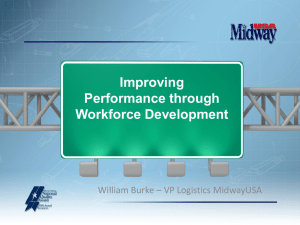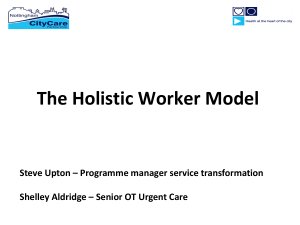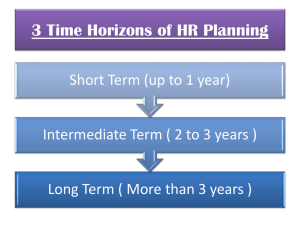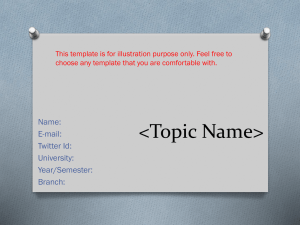Plan for Workforce Training - The National Association of County
advertisement
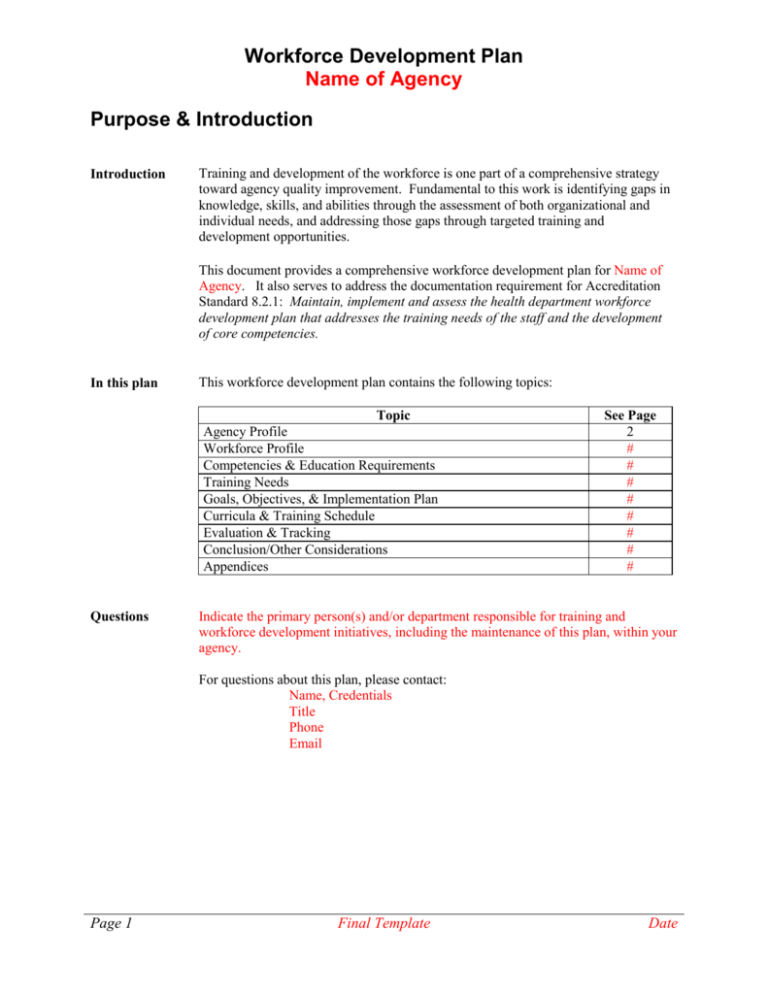
Workforce Development Plan Name of Agency Purpose & Introduction Introduction Training and development of the workforce is one part of a comprehensive strategy toward agency quality improvement. Fundamental to this work is identifying gaps in knowledge, skills, and abilities through the assessment of both organizational and individual needs, and addressing those gaps through targeted training and development opportunities. This document provides a comprehensive workforce development plan for Name of Agency. It also serves to address the documentation requirement for Accreditation Standard 8.2.1: Maintain, implement and assess the health department workforce development plan that addresses the training needs of the staff and the development of core competencies. In this plan This workforce development plan contains the following topics: Topic Agency Profile Workforce Profile Competencies & Education Requirements Training Needs Goals, Objectives, & Implementation Plan Curricula & Training Schedule Evaluation & Tracking Conclusion/Other Considerations Appendices Questions See Page 2 # # # # # # # # Indicate the primary person(s) and/or department responsible for training and workforce development initiatives, including the maintenance of this plan, within your agency. For questions about this plan, please contact: Name, Credentials Title Phone Email Page 1 Final Template Date Agency Profile Mission & vision Briefly describe the guiding principles for the agency including mission and vision. If your agency has a strategic plan, it may be referenced here or included in the appendix. Location & population served Briefly describe the geographic area where the agency is located and the population it serves, including: City/County/Jurisdiction Population/Demographics (Resource: http://www.census.gov/) Other public health agencies that serve the population (for example shared services) Governance Briefly describe the governance of the agency which may include: Board of Health District Advisory Council Health Commissioner Organizational structure Lead sentence(s), followed by bulleted list of points that describe the leadership structure. Consider including an organizational chart in the appendix. Learning culture Describe your agency’s learning environment/culture or philosophy. Note how this workforce development plan contributes to the overall desired culture of learning and quality/performance improvement. Funding Briefly describe how the agency is funded (ex. grants, levy, fees, contracts, etc.). Also include annual training budget, if applicable. Consider including line item training budget in appendix if useful/applicable. Workforce policies Briefly state where policies guiding workforce training and development documents are located within the agency. Page 2 Final Template Date Workforce Profile Introduction This section provides a description of the Name of Agency’s current and anticipated future workforce needs. Current workforce demographics The table below summarizes the demographics of the agency’s current workforce as of Date: (Note: Subcategorize as needed.) Category Total # of Employees: # of FTE: % Paid by Grants/Contracts: Gender: Female: Male: Race: Hispanic: Non-Hispanic: American Indian / Alaska Native: Asian: African American: Hawaiian: Caucasian: More than One Race: Other: Age: < 20: 20 – 29: 30 – 30: 40 – 49: 50 – 59: >60: Primary Professional Disciplines/Credentials: Leadership/Administration: Nurse: Registered Sanitarian/EH Specialist: Epidemiologist: Health Educator: Dietician: Social Workers: Medical Directors: Other: Other: Retention Rate per 5 or 10 Years; by discipline if applicable Employees < 5 Years from Retirement: Management: Non-Management: Other Other Page 3 Final Template # or % # # % # # # # # # # # # # # # # # # # # # # # # # # # # # # # # # # # Date Workforce Profile, continued Future workforce Page 4 Briefly describe the anticipated future workforce needs of the agency. Consider anticipated population and professional needs, including: population growth and demographic forecasts, higher education standards (in general or by discipline), certification or credential requirements, leadership succession, and emerging issues that would require advancement of knowledge, skills, and/or abilities. Final Template Date Competencies & Education Requirements Core competencies for agency Describe the core competency set used by the agency to guide professional development. Accreditation Note: This is a requirement of Standard 8.2.1. If a competency set has not been identified, consider using the Council on Linkages Core Competencies for Public Health Professionals, as these are considered to be the national standard guiding the development of the current and future workforce. http://www.phf.org/resourcestools/pages/core_public_health_competencies.aspx Other competencies (if needed) Lead sentence followed by bulleted list of other competency sets utilized by the agency. Examples include, but are not limited to: Discipline-Specific Competencies: Public Health Leadership, Nursing, Environmental Health, Preparedness and Emergency Response, Health Education, etc. Organizational Competencies: Competencies identified and adopted by the agency. See Template User Guide & Resource Manual for links to discipline-specific competencies. Consider including copies of any additional competency sets in the appendix. CE required by discipline Multiple public health-related disciplines require continuing education for ongoing licensing/practice. Licensures held by staff, and their associated CE requirements, are shown in the table below. (See Template User Guide & Resource Manual for links to CE providers listed here. Note that some of these requirements are Ohiospecific.) Discipline Nursing Registered Sanitarian Health Educator (CHES/MCHES) Certified Public Health Practitioner Physician Social Worker (LSW, LISW, MSW, etc.) Dietitian (RD, LD) Ohio CE Requirements (as of Date) 24 contact hours every 2 years 18 CEUs per year 75 CECH every 5 years 50 hours every 2 years 100 hours every 2 years 30 hours every 2 years, 3 in ethics 75 CPEUs every 5 years by the Commission on Dietetic Registration (CDR), 50 CPEUs every 2 years by the Ohio Board of Dietetics (OBD). Other Page 5 Final Template Date Training Needs Introduction This section describes both identified and mandatory training needs within the agency. (Note: If no training needs assessment data exists, describe how training needs will be identified.) Training needs assessment results Provide a high-level overview of any competency-based training needs assessment results. Include tables if need be. Consider referencing the full report here and including a copy in the appendix. Other needs assessment results may be highlighted here as well such as: organizational culture survey agency climate survey talent assessments health equity survey Agency-specific needs Lead sentence(s) with bulleted list of points that describe training needs based on strategic direction of the organization. Include tables if needed. These needs are usually in alignment with the agency’s strategic plan and future direction. Lead sentence(s) with bulleted list of points that describe training needs by discipline Disciplinespecific training and/or per credentialing requirements. Include tables if need be. needs (if applicable) Page 6 Final Template Date Training Needs, continued Mandatory training The table below lists training required by the agency and/or by state or federal mandate: Examples provided below for guidance. Delete and insert your agency’s mandatory training requirements here. Note that these mandatory training needs should also be reflected in the Curricula & Training Schedule section of this plan. Training Who Ex. HIPPA Ex. Bloodborne Pathogens Other information Page 7 All staff Nursing Staff Frequency Annually Annually List other relevant information gathered from the surveys, direct observation, customer service feedback, or agency strategic direction. Final Template Date Goals, Objectives, & Implementation Plan Introduction This section provides information regarding training goals and objectives of the agency, as well as resources, roles, and responsibilities related to the implementation of the plan. Goals should address both individual and agency-based training needs identified in the previous section. If other factors were considered, state them here. Sample goals and objectives are included in italics in the table provided on the following page. Roles & responsibilities The table below lists individuals responsible for the implementation of this plan as well as the associated roles and responsibilities. This table is designed for use by a local health department and should be modified based on agency structure/need. Who Board of Health Health Commissioner Human Resources Division/Department Directors (eg. Director of Nursing) Supervisors All Employees Page 8 Roles & Responsibilities Ultimately responsible for ensuring resource availability to implement the workforce development plan. Responsible to the Board of Health for workforce strategy, priority setting, establishment of goals and objectives, and establishing an environment that is conducive and supportive of learning. Identifies high potential employees as part of agency succession plan. Provide guidance to the Health Commissioner regarding workforce development and assist in creating a culture that is conducive and supportive of learning. Works with Directors to find appropriate training/development opportunities for staff. Provide guidance to the Directors with coaching, mentoring and succession planning. Responsible for informing supervisors of workforce development needs, plans, and issues. Responsible to the Health Commissioner for all employees within their divisions. Supports, coaches, and mentors supervisors and/or employees to assure that appropriate training resources and support structures are available within the division. Identifies high potential employees as part of agency succession plan. Responsible to their Director and employees to ensure that individual and agency-based training initiatives are implemented. Works with employee to develop an individualized learning plan and supports the implementation of the plan (ie. time away from work, coaching, opportunities for application, tuition reimbursement). Identifies high potential employees as part of agency succession plan. Ultimately responsible for their own learning and development. Work with supervisor to identify and engage in training and development opportunities that meet their individual as well as agency-based needs. Identify opportunities to apply new learning on the job. Final Template Agency Name Training Goals & Objectives 20XX - 20XX Examples included below for guidance. Delete examples and add your agency’s goals and objectives here. Goal Objectives Ex. Establish a culture of quality within the agency Ex. Establish individualized professional development plans for all employees Page 9 Target Audience By 2012 all senior managers will participate in quality improvement training By 2013 all senior managers will lead an internal quality improvement team Annually, as part of performance review process, all employees will create an individualized professional development plan. Resources Responsible Party Division/Department Directors; Supervisors OSU-CPHP CQI NACCHO Health Commissioner All staff Performance evaluations Employee and Supervisor Final Template Date Goals, Objectives, & Implementation Plan, continued Communication plan Describe how this plan will be shared with agency personnel, including how updates will be communicated. Use if needed Use if needed Page 10 Final Template Date Agency Name Curricula & Training Schedule 20XX - 20XX Introduction This section describes the curricula and training schedule for Name of Agency. Accreditation Note: This section is required if using this plan to meet the documentation requirements associated with Accreditation Standard 8.2.1. Additional training requirements for agency accreditation include: Leadership and management development activities (Standard 8.2.2) Staff training on patient confidentiality policies (Standard 11.1.2) One training on social, cultural, and /or linguistic factors (Standard 11.1.3) Staff development in performance management (Standard 9.2.5) Examples provided in italics below for guidance. Delete and insert your agency’s training schedule here. Topic Ex. Continuous Quality Improvement Ex. Public Health Combined Conference Ex. HIPPA Compliance Page 11 Description Target Audience Competencies Addressed Schedule Resources Three module, online introduction to CQI basics QI team members Senior Leadership COL Core: 8A7, 8B7, 8C7 August 2012 www.cphplearn.org Annual Ohio conference for public health practitioners; CE opportunity Mandatory training on patient confidentiality Senior Leadership Varies May 2012 www.ohiopha.org All Staff Mandate Annually Link to online HIPPA training here Final Template Date Evaluation and Tracking Introduction Evaluation of training will provide Agency Name with useful feedback regarding its efforts, including content, delivery, vendor preferences, and training effectiveness. Accurate evaluation tracking is necessary, particularly for professional continuing education documentation and quality improvement purposes. This section describes how evaluation and tracking of training will be conducted. Evaluation Briefly describe how training will be evaluated. Methods may be contingent upon: the training provider, hard-copy or electronic collection, continuing education reporting requirements, and other influences. Consider how you will measure increased competency and application of training both subjectively and objectively. Also consider return-on-investment measures. Consider the Kirkpatrick Model as a guide: http://www.kirkpatrickpartners.com/ See Template User Guide & Resource Manual for additional evaluation-related resources; including a sample Level 1 evaluation form. Tracking Briefly describe how training will be tracked including: names, dates, locations, and collection of supportive documents and completion transcripts/records. Consider that tracking may be done electronically, departmentally, or agency-wide and may be in real-time or on a regularly scheduled basis, such as during annual performance reviews. Local public health departments in Ohio are encouraged by the state health department to use OhioTRAIN as a resource for tracking employee training. Located at http://oh.train.org, the system has the ability to create and maintain personal learning records, perform course searches, and provide the ability to register for courses online. Accreditation Note: Documentation of staff training is required. Documentation may include: attendee list, certificates of completion, transcripts, sign in sheets. See the PHAB Accreditation Standards for specific information about documentation of participation for required training. Page 12 Final Template Date Conclusion / Other Considerations Other agency documents and plans Briefly describe how this Workforce Development Plan relates to other efforts within the organization, for instance: strategic, succession, or quality improvement plans. Review of plan Describe the plan for regular review and revision of this document: who will do it, how it will be done, and with what frequency. Include who is responsible for maintaining the plan. Authorship This plan was developed by the following individuals, and finalized on DATE. Create additional rows as needed. Printed Name & Title Signature Date Development of this template was made possible, in part, by the Ohio Public Health Training Center located in the College of Public Health at The Ohio State University; grant number UB6HP20203, from the Health Resources and Services Administration, DHHS, Public Health Training Center Program. Contents are solely the responsibility of the authors and do not necessarily represent the official views of HRSA. Page 13 Final Template Date Appendix A: If Needed Page 14 Final Template Date



